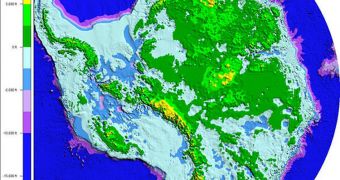Investigators from the Stellenbosch University in South Africa, led by environmental scientists Steven Chown, demonstrate in a new study that the Southern Continent has been contaminated with the seeds of potentially-invasive plants, which may threaten the extremely fragile Antarctic ecosystem.
While several species of plants and animals mange to endure in the desolate landscape, the relations that formed between them are extremely sensitive, and prone to receiving a lot of damage. This is precisely what would happen if new, invasive species were introduced in the environment.
As if things weren't bad enough right now, climatologists say that global warming will make the Southern Continent even more hospitable to invading species (not all of them plants) in the future.
With increased global temperatures, more ice would melt, exposing the ground underneath. The entire Southern Continent is in fact a large archipelago, as demonstrated by the image to the left. The rendition displays the subglacial topography and bathymetry of Antarctica.
When some of the ice sheets melt, global sea levels will increase as well, further modifying shore lines around the world, including at the South Pole. This will make it even easier for species from other locations to invade the pristine continent.
Unfortunately, humans are the main vectors by which the damaging species spread. An increased presence in the Antarctica by both visitors and scientists – all conducting various expeditions – increased the chances of some microorganisms or plants from elsewhere to arrive in Antarctica.
In a study conducted between 2007 and 2008, Chown and his group scanned the luggage of 850 people visiting the continent for various reasons. They discovered in excess of 2,700 seeds belonging to different plants on equipment, clothes, shoes and so on, Daily Galaxy reports.
The investigation revealed that, on average, a tourist carries 2-3 seeds, while a scientist carries six. However, the total number of tourists for the 2007-2008 Antarctic summer was 33,000, whereas only 7,000 scientists arrived at the South Pole during the same interval.
Therefore, Chown believes that both scientists and tourists pose a similar risk to the continent's habitats. The findings will soon be presented to the Committee for Environmental Protection of the Antarctic Treaty, for a more detailed analysis.

 14 DAY TRIAL //
14 DAY TRIAL //